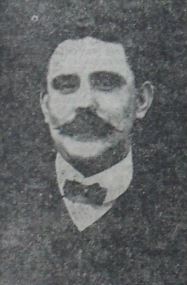Pte
Thomas O'Connor
Informationen zu Geburt
|
Geburtsdatum: 11/03/1885 |
|
Geburtsort: Birkenhead, Cheshire, England, Vereinigtes Königreich |
Allgemeine Informationen
|
Beruf: Werft Arbeiter - Cammell Laird/ Special Constable |
Informationen zum Armeedienst
|
Land: England, Vereinigtes Königreich |
|
Truppe: British Expeditionary Force |
|
Rang: Private |
|
Dienstnummer: 239129 |
|
Einberufung ort: Birkenhead, Cheshire, England, Vereinigtes Königreich |
|
Einheiten: — Herefordshire Regiment, 5th Bn. attd. King's Shropshire Light Infantry, 5th Bn. (Angeschlossen) |
Informationen zu Tod
|
Sterbedatum: 22/08/1917 |
|
Sterbeort: Glencorse Wood, Zonnebeke, Belgien |
|
Todesursache: Im Kampf gefallen |
|
Alter: 32 |
Gedenkstätte
|
Tyne Cot Memorial Tafel: 154A |
Auszeichnungen und Orden 2
|
British War Medal Medaille |
|
Victory Medal Medaille |
Punkte von Interesse 3
| #1 | Geburtsort | ||
| #2 | Einberufung ort | ||
| #3 | Ort des Todes (ungefähr) |
Meine Geschichte
Private Thomas O’Connor served in the Herefordshire Regiment, 5th Battalion, but was attached to the 5th Battalion of the King’s Shropshire Light Infantry, part of the 42nd Brigade, of the 14th (Light) Division.
On the 22nd of August 1917 the Battalion took part in an advance by the 14th Division through Glencorse Wood. “A” and “B” Companies were positioned in Jargon Trench, with outposts as far as Glencorse Wood. “D” Company was in support at Jargon Switch and “C” Company functioned as a reserve in Ignorance Trench.
At zero hour “A” and “B” Companies were the first to jump-off. They advanced through Glencorse Wood and quickly captured their objective throughout the line. Only the right flank wasn’t captured, because the parties on the right had to maintain connection with the 43rd Brigade, which was held up by machine gun fire from Fitzclarence Farm.
The going had been hard. Both Companies had to face heavy German machine gun fire. Within five minutes of the advance “B” Company, on the left, had lost almost all its officers. Consequently the line had been broken on several places and “B” Company needed to be reorganized by a Captain from “D” Company. Communications between the two Companies were restored, but “A” Company, on the right, was no longer in touch with the 43rd Brigade. Casualties kept stacking up and more officers were sent up to replace the fallen or wounded officers in the frontline. By noon at least a fourth of the Battalion was killed, wounded or missing. Notwithstanding the heavy casualties the Battalion held the line, and managed to establish contact with the 43rd Brigade on the right.
During the night the Germans launched a heavy counterattack on the 43rd Brigade, which was fend off with the help from machine guns of the King’s Shropshire Light Infantry, 5th Battalion. The Battalion held its ground till it was relieved on the night of the 23rd and 24th of August 1917. The Battalion had suffered heavy casualties. Twenty men were killed, and 111 men were wounded; twelve men went missing.
Private Thomas O’Connor was killed in action on the 22nd of August 1917, while the King’s Shropshire Light Infantry 5th Battalion advanced through Glencorse Wood. His remains were not recovered and he is remembered on the Tyne Cot Memorial.
On the 22nd of August 1917 the Battalion took part in an advance by the 14th Division through Glencorse Wood. “A” and “B” Companies were positioned in Jargon Trench, with outposts as far as Glencorse Wood. “D” Company was in support at Jargon Switch and “C” Company functioned as a reserve in Ignorance Trench.
At zero hour “A” and “B” Companies were the first to jump-off. They advanced through Glencorse Wood and quickly captured their objective throughout the line. Only the right flank wasn’t captured, because the parties on the right had to maintain connection with the 43rd Brigade, which was held up by machine gun fire from Fitzclarence Farm.
The going had been hard. Both Companies had to face heavy German machine gun fire. Within five minutes of the advance “B” Company, on the left, had lost almost all its officers. Consequently the line had been broken on several places and “B” Company needed to be reorganized by a Captain from “D” Company. Communications between the two Companies were restored, but “A” Company, on the right, was no longer in touch with the 43rd Brigade. Casualties kept stacking up and more officers were sent up to replace the fallen or wounded officers in the frontline. By noon at least a fourth of the Battalion was killed, wounded or missing. Notwithstanding the heavy casualties the Battalion held the line, and managed to establish contact with the 43rd Brigade on the right.
During the night the Germans launched a heavy counterattack on the 43rd Brigade, which was fend off with the help from machine guns of the King’s Shropshire Light Infantry, 5th Battalion. The Battalion held its ground till it was relieved on the night of the 23rd and 24th of August 1917. The Battalion had suffered heavy casualties. Twenty men were killed, and 111 men were wounded; twelve men went missing.
Private Thomas O’Connor was killed in action on the 22nd of August 1917, while the King’s Shropshire Light Infantry 5th Battalion advanced through Glencorse Wood. His remains were not recovered and he is remembered on the Tyne Cot Memorial.
Quellen 2
|
5 Battalion King's Shropshire Light Infantry , (The National Archives, KEW (TNA), WO 95/1902/1 ). https://discovery.nationalarchives.gov.uk/details/r/C14303 Weitere Quellen |
|
Wood B., The History of the King's Shropshire Light Infantry in the Great War, (London, The Medici Society. LTD, 1925), pg. 156-159. Verwendete Quellen |
Weitere Informationen 3
|
Commonwealth War Graves Commission Database https://www.cwgc.org/find-records/find-war-dead/casualty-details/832556 |
|
Namenlijst (In Flanders Fields Museum) https://namenlijst.org/publicsearch/#/person/_id=cdefb16d-3963-468c-b066-b4fe79b0c12d |
|
Lives of the First World War (Imperial War Museum) https://livesofthefirstworldwar.iwm.org.uk/lifestory/3302809 |
